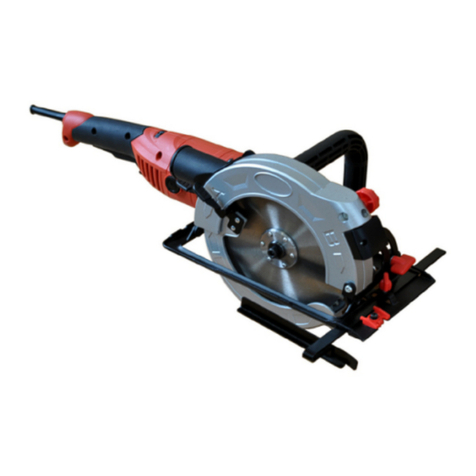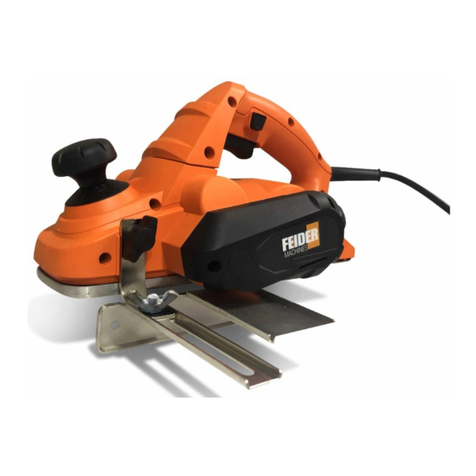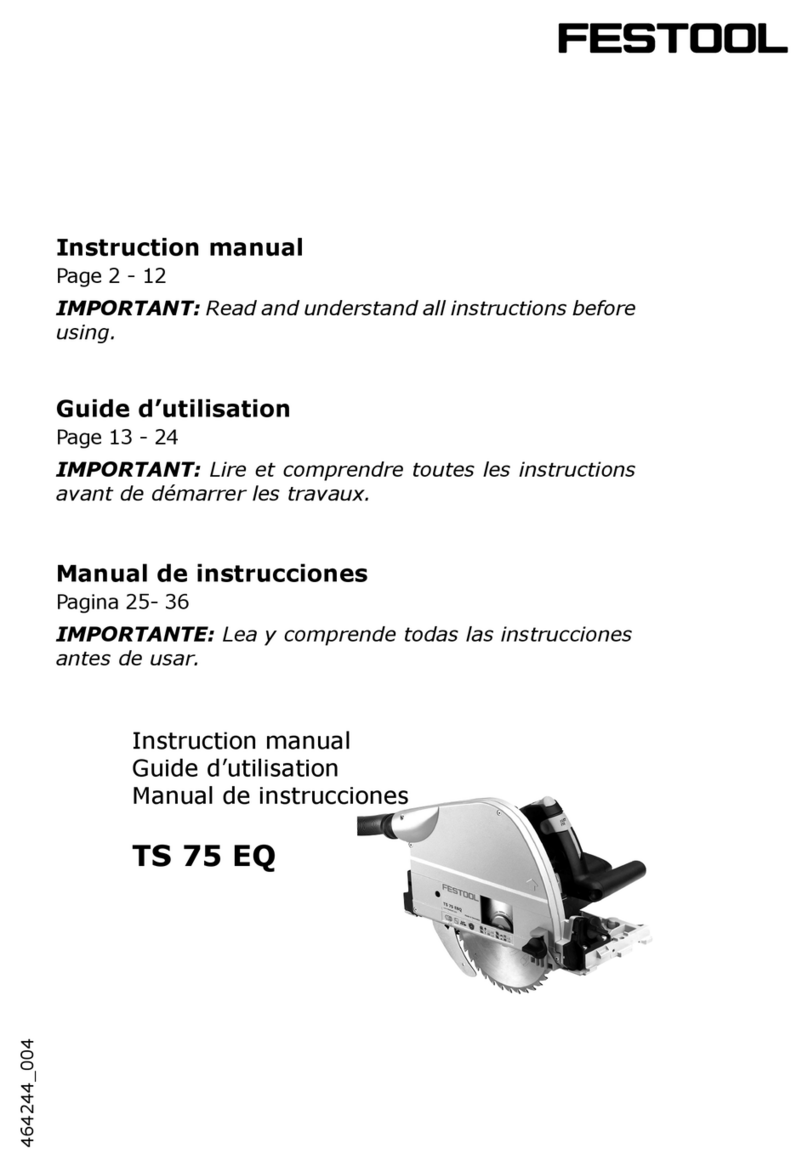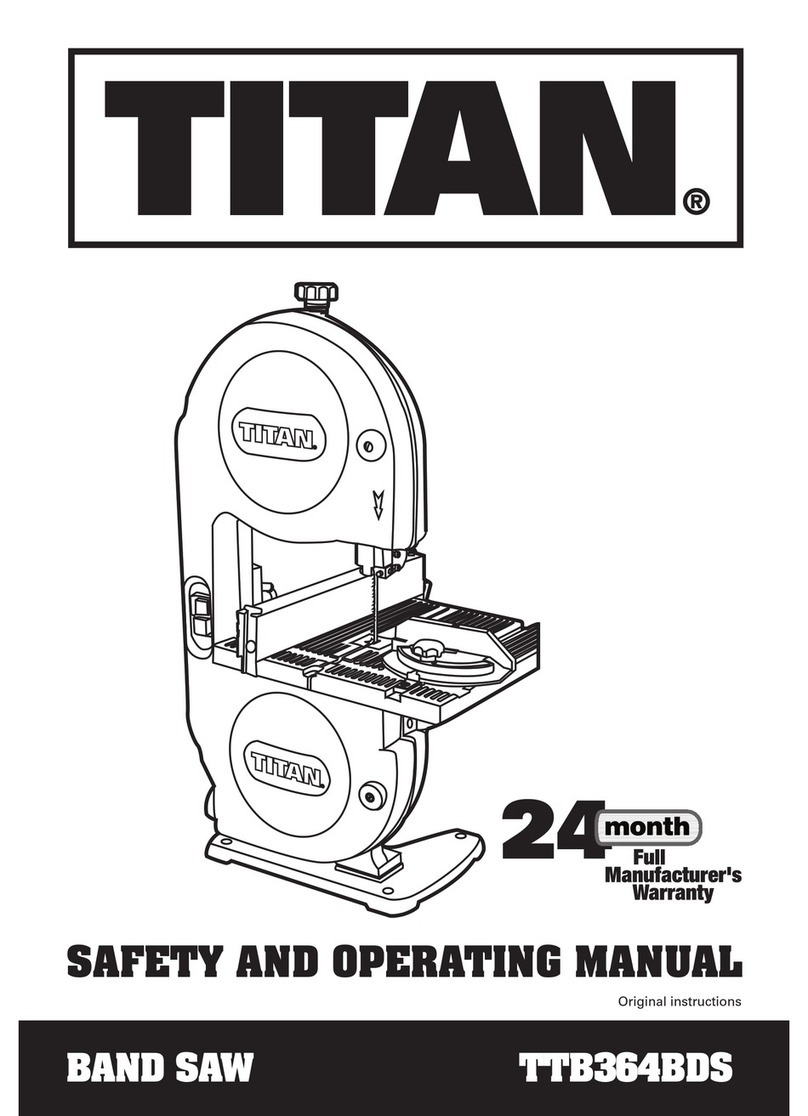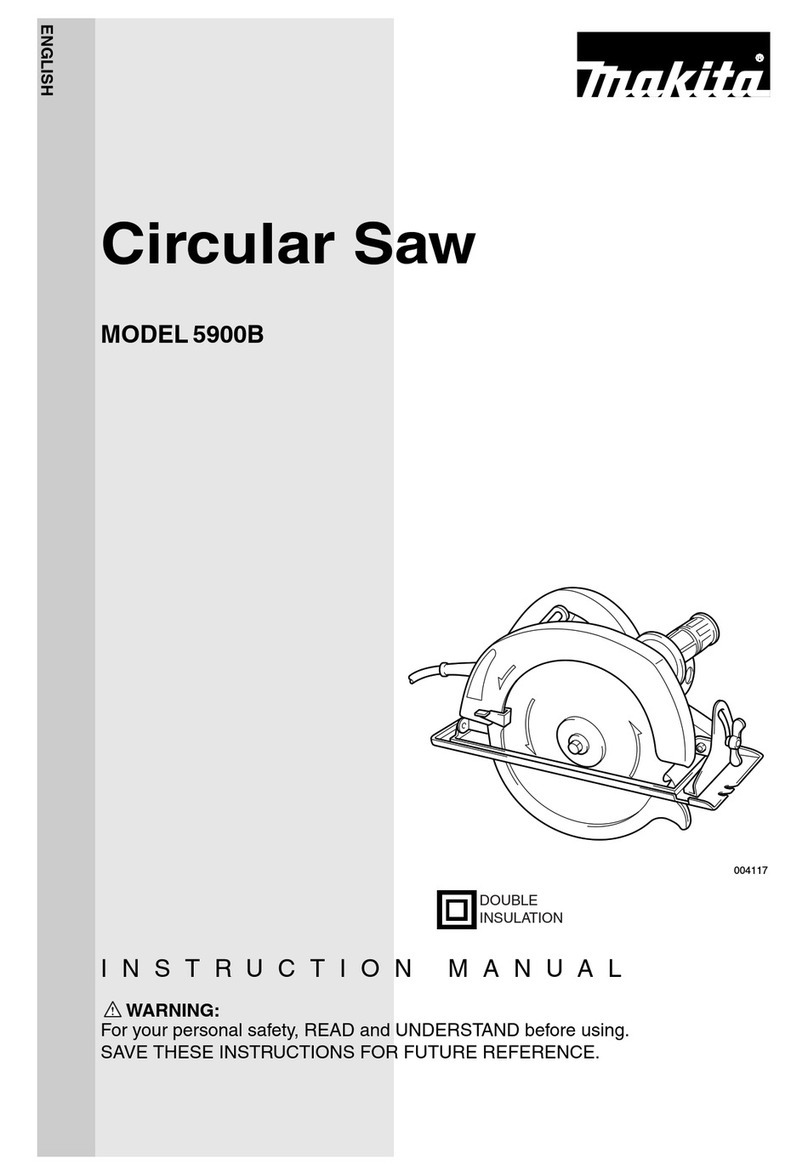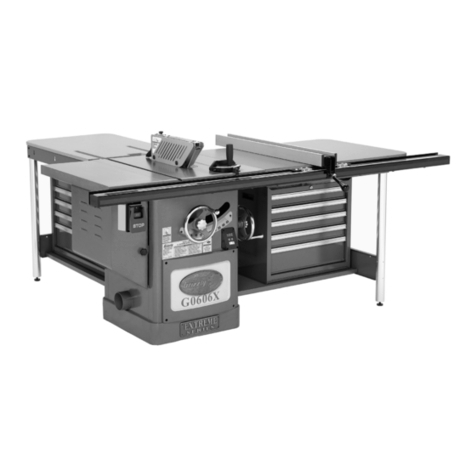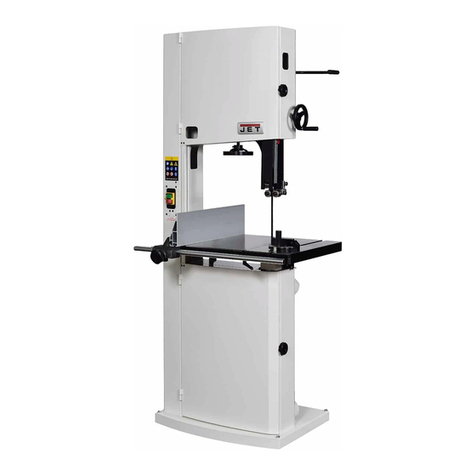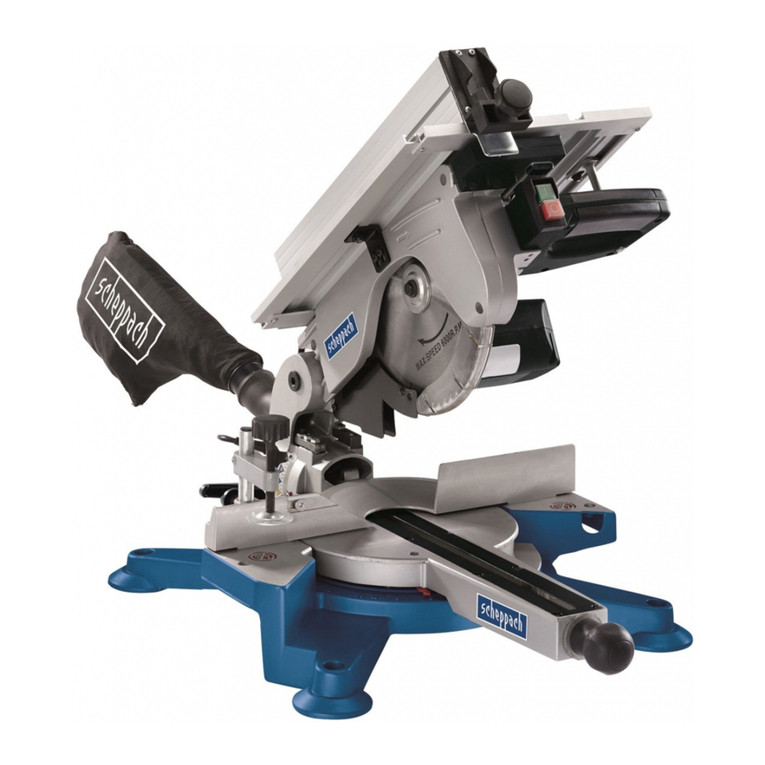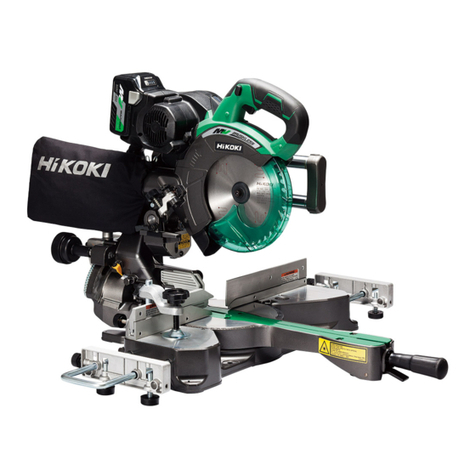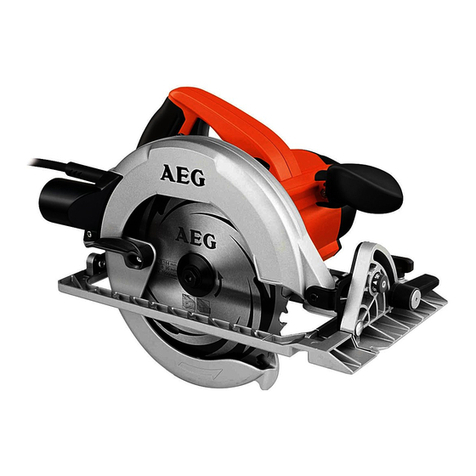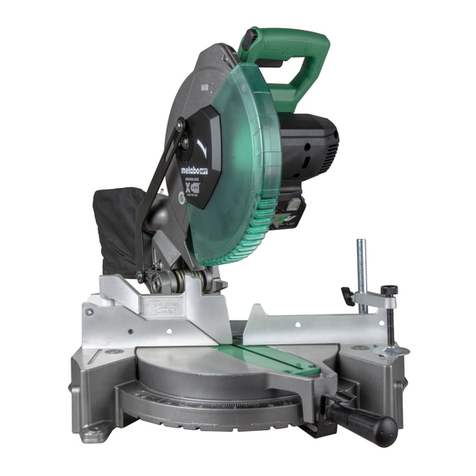Feider Machines FSC20235 User manual

EN
ORIGINAL INSTRUCTIONS
Instruction Manual
Circular Saw
Model FSC20235
BUILDER SAS
32, rue Aristide Bergès-ZI 31270 Cugnaux, France
MADE IN PRC
Warning: Please read the manual carefully before using the unit!

EN
Fig. 1 Fig. 2
Fig. 3 Fig. 4 Fig. 5
Fig. 6 Fig.7 Fig. 8
02

EN
1. SAFETY INSTRUCTIONS
General power tool safety warnings
WARNING Read all safety warnings, instructions, illustrations and specifications provided
with this power tool. Failure to follow all instructions listed below may result in electric shock,
fire and/or serious injury.
Save all warnings and instructions for future reference.
The term "power tool" in the warnings refers to your mains-operated (corded) power tool or
battery-operated (cordless) power tool.
1) Work area safety
a) Keep work area clean and well lit.Cluttered or dark areas invite accidents.
b) Do not operate power tools in explosive atmospheres, such as in the presence of
flammable liquids, gases or dust. Power tools create sparks which may ignite the dust or
fumes.
c) Keep children and bystanders away while operating a power tool. Distractions can cause
you to lose control.
2) Electrical safety
a) Power tool plugs must match the outlet. Never modify the plug in any way. Do not use
any adapter plugs with earthed (grounded) power tools. Unmodified plugs and matching
outlets will reduce risk of electric shock.
b) Avoid body contact with earthed or grounded surfaces, such as pipes, radiators, ranges
and refrigerators. There is an increased risk of electric shock if your body is earthed or
grounded.
c) Do not expose power tools to rain or wet conditions. Water entering a power tool will
increase the risk of electric shock.
d) Do not abuse the cord. Never use the cord for carrying, pulling or unplugging the power
tool. Keep cord away from heat, oil, sharp edges or moving parts. Damaged or entangled
cords increase the risk of electric shock.
e) When operating a power tool outdoors, use an extension cord suitable for outdoor use.
Use of a cord suitable for outdoor use reduces the risk of electric shock.
f) If operating a power tool in a damp location is unavoidable, use a residual current device
(RCD) protected supply. Use of an RCD reduces the risk of electric shock.
NOTE The term “residual current device (RCD)” can be replaced by the term “ground fault
circuit interrupter (GFCI)” or “earth leakage circuit breaker (ELCB)”.
03

EN
3) Personal safety
a) Stay alert, watch what you are doing and use common sense when operating a power
tool. Do not use a power tool while you are tired or under the influence of drugs, alcohol or
medication. A moment of inattention while operating power tools may result in serious
personal injury.
b) Use personal protective equipment. Always wear eye protection. Protective equipment
such as a dust mask, non-skid safety shoes, hard hat or hearing protection used for
appropriate conditions will reduce personal injuries.
c) Prevent unintentional starting. Ensure the switch is in the off-position before connecting
to power source and/or battery pack, picking up or carrying the tool. Carrying power tools
with your finger on the switch or energising power tools that have the switch on invites
accidents.
d) Remove any adjusting key or wrench before turning the power tool on. A wrench or a key
left attached to a rotating part of the power tool may result in personal injury.
e) Do not overreach. Keep proper footing and balance at all times. This enables better
control of the power tool in unexpected situations.
f) Dress properly. Do not wear loose clothing or jewellery. Keep your hair and clothing away
from moving parts. Loose clothes, jewellery or long hair can be caught in moving parts.
g) If devices are provided for the connection of dust extraction and collection facilities,
ensure these are connected and properly used. Use of dust collection can reduce dust-related
hazards.
h) Do not let familiarity gained from frequent use of tools allow you to become complacent
and ignore tool safety principles. A careless action can cause severe injury within a fraction of
a second.
4) Power tool use and care
a) Do not force the power tool. Use the correct power tool for your application. The correct
power tool will do the job better and safer at the rate for which it was designed.
b) Do not use the power tool if the switch does not turn it on and off. Any power tool that
cannot be controlled with the switch is dangerous and must be repaired.
c) Disconnect the plug from the power source and/or remove the battery pack, if
detachable, from the power tool before making any adjustments, changing accessories, or
storing power tools. Such preventive safety measures reduce the risk of starting the power
tool accidentally.
04

EN
d) Store idle power tools out of the reach of children and do not allow persons unfamiliar
with the power tool or these instructions to operate the power tool. Power tools are
dangerous in the hands of untrained users.
e) Maintain power tools and accessories. Check for misalignment or binding of moving parts,
breakage of parts and any other condition that may affect the power tool’s operation. If
damaged, have the power tool repaired before use. Many accidents are caused by poorly
maintained power tools.
f) Keep cutting tools sharp and clean. Properly maintained cutting tools with sharp cutting
edges are less likely to bind and are easier to control.
g) Use the power tool, accessories and tool bits etc. in accordance with these instructions,
taking into account the working conditions and the work to be performed. Use of the power
tool for operations different from those intended could result in a hazardous situation.
h) Keep handles and grasping surfaces dry, clean and free from oil and grease. Slippery
handles and grasping surfaces do not allow for safe handling and control of the tool in
unexpected situations.
5) Service
a) Have your power tool serviced by a qualified repair person using only identical
replacement parts. This will ensure that the safety of the power tool is maintained.
Safety instructions for all saws
Cutting procedures
a) DANGER: Keep hands away from cutting area and the blade. Keep your second hand on
auxiliary handle, or motor housing. If both hands are holding the saw, they cannot be cut by
the blade.
NOTE For circular saws with a maximum blade diameter of 140 mm or smaller, the words "Keep your second hand on
auxiliary handle, or motor housing" do not apply.
b) Do not reach underneath the workpiece. The guard cannot protect you from the blade
below the workpiece.
c) Adjust the cutting depth to the thickness of the workpiece. Less than a full tooth of the
blade teeth should be visible below the workpiece.
d) Never hold the workpiece in your hands or across your leg while cutting. Secure the
workpiece to a stable platform. It is important to support the work properly to minimise body
exposure, blade binding, or loss of control.
e) Hold the power tool by insulated gripping surfaces, when performing an operation where
the cutting tool may contact hidden wiring or its own cord. Contact with a "live" wire will
05

EN
also make exposed metal parts of the power tool "live" and could give the operator an electric
shock.
f) When ripping, always use a rip fence or straight edge guide. This improves the accuracy of
cut and reduces the chance of blade binding.
g) Always use blades with correct size and shape (diamond versus round) of arbour holes.
Blades that do not match the mounting hardware of the saw will run off-centre, causing loss
of control.
h) Never use damaged or incorrect blade washers or bolt. The blade washers and bolt were
specially designed for your saw, for optimum performance and safety of operation.
Further safety instructions for all saws
Kickback causes and related warnings
– kickback is a sudden reaction to a pinched, jammed or misaligned saw blade, causing an
uncontrolled saw to lift up and out of the workpiece toward the operator;
– when the blade is pinched or jammed tightly by the kerf closing down, the blade stalls and
the motor reaction drives the unit rapidly back toward the operator;
– if the blade becomes twisted or misaligned in the cut, the teeth at the back edge of the
blade can dig into the top surface of the wood causing the blade to climb out of the kerf and
jump back toward the operator.
Kickback is the result of saw misuse and/or incorrect operating procedures or conditions and
can be avoided by taking proper precautions as given below.
a) Maintain a firm grip with both hands on the saw and position your arms to resist
kickback forces. Position your body to either side of the blade, but not in line with the blade.
Kickback could cause the saw to jump backwards, but kickback forces can be controlled by the
operator, if proper precautions are taken.
NOTE For circular saws with a maximum blade diameter of 140 mm or smaller, the words "with both hands" do not
apply.
b) When blade is binding, or when interrupting a cut for any reason, release the trigger and
hold the saw motionless in the material until the blade comes to a complete stop. Never
attempt to remove the saw from the work or pull the saw backward while the blade is in
motion or kickback may occur. Investigate and take corrective actions to eliminate the cause
of blade binding.
c) When restarting a saw in the workpiece, centre the saw blade in the kerf so that the saw
teeth are not engaged into the material. If a saw blade binds, it may walk up or kickback
from the workpiece as the saw is restarted.
06

EN
d) Support large panels to minimise the risk of blade pinching and kickback. Large panels
tend to sag under their own weight. Supports must be placed under the panel on both sides,
near the line of cut and near the edge of the panel.
e) Do not use dull or damaged blades. Unsharpened or improperly set blades produce narrow
kerf causing excessive friction, blade binding and kickback.
f) Blade depth and bevel adjusting locking levers must be tight and secure before making
the cut. If blade adjustment shifts while cutting, it may cause binding and kickback.
g) Use extra caution when sawing into existing walls or other blind areas. The protruding
blade may cut objects that can cause kickback.
Safety instructions for saws with pendulum guard and saws with tow guard
Lower guard function
a) Check the lower guard for proper closing before each use. Do not operate the saw if the
lower guard does not move freely and close instantly. Never clamp or tie the lower guard
into the open position. If the saw is accidentally dropped, the lower guard may be bent. Raise
the lower guard with the retracting handle and make sure it moves freely and does not touch
the blade or any other part, in all angles and depths of cut.
NOTE Alternate wording for "retracting handle" is possible.
b) Check the operation of the lower guard spring. If the guard and the spring are not
operating properly, they must be serviced before use. Lower guard may operate sluggishly
due to damaged parts, gummy deposits, or a build-up of debris.
c) The lower guard may be retracted manually only for special cuts such as "plunge cuts"
and "compound cuts". Raise the lower guard by the retracting handle and as soon as the
blade enters the material, the lower guard must be released. For all other sawing, the lower
guard should operate automatically.
NOTE Alternate wording for "retracting handle" is possible.
d) Always observe that the lower guard is covering the blade before placing the saw down
on bench or floor. An unprotected, coasting blade will cause the saw to walk backwards,
cutting whatever is in its path. Be aware of the time it takes for the blade to stop after switch
is released.
Warning: Keep hands away from the cutting area and blade. NEVER place your hands behind
the saw blade since kickback could cause the saw to jump backwards over your hand. Keep
your body positioned to either side of the saw blade.
1. Check the lower guard for proper closing before each use. If the saw is accidentally
dropped, the lower guard may be bent. Raise the lower guard with the lower guard lever
07

EN
and make sure it can move freely and does not touch the blade or any other parts in all
angles and depths of cutting. Do not operate the saw if the lower guard does not move
and close freely. Never clamp or tie the lower guard into the open position.
2. Adjust the cutting depth to the thickness of the workpiece. Less than a full tooth of the
blade teeth should be visible below the workpiece.
3. Never hold piece being cut in your hands or across your leg. Secure the workpiece to a
stable platform. It is important to support the work properly to minimize body exposure,
blade binding, or loss of control.
4. Hold tool by insulated gripping surfaces when performing an operation where the cutting
tool may contact hidden wiring or its own cord. Contact with a “live” wire will make
exposed metal parts of the tool “live” and shock the operator.
5. Always observe the lower guard to see if it covers the entire blade before placing the saw
on the bench or floor. Please pay attention to the time it needs to take for the blade to
stop after released the switch.
6. When operating the saw, keep the cord away from the cutting area and position so that it
might be caught by the work piece during the cutting operation.
7. Keep your second hand on the motor housing or auxiliary handle, not close to the blade.
Do not reach underneath the work or attempt to remove the cutting material when the
blade is still moving.
8. It is important to support the work properly and to hold the saw firmly to prevent from
loss of control, which might cause personal injury. NEVER hold the pieces for cutting in
your hands or across your legs.
9. Making a “Pocket Cut” into existing walls or other blind area is dangerous. the protruding
blade may cut “live wires” or objects that may cause kickback.
10. When cutting is interrupted or the blade bound, please release the trigger immediately
and hold the saw firmly in the material until the blade comes to a complete stop. Never
attempt to remove the saw from the work or pull the saw backward while the blade is in
motion, otherwise, kickback might happen.
11. Use a rip fence or straight edge guide when ripping.
12. Avoid cutting nails, inspect the material that is being cut to see if there are nails in it and
remove before cutting.
13. Do not run the saw while carrying it at your side.
14. Make sure the depth and bevel adjusting locking levers are tight and secure before
making a cut.
15. Do not use damaged or dull blades. Because unshaped or improperly set blades will
08

EN
produce narrow kerfs which may cause excessive friction, blade binding or kickback etc.
16. Always use blades with correct size arbor holes, never use defective or incorrect blade
washers or bolts.Do not use abrasive discs in place of the saw blades specified in this
manual.
17. Make sure to use a blade adapted to the material to be cut. Read and compare the
information in this manual with the information on the saw blade.
18. Use only blades that are marked with a speed equal to or greater than the speed on the
tool.
19. Double check to make sure that accessories (including blade protection) and
attachments are properly attached. Run a no-load test for one minute to detect any
problems.
20. Fix the piece to be cut. The workpiece is secured more securely if it is held by a clamp or
vice rather than by hand.
21. If the blade gets stuck, turn off the tool immediately and get ready: a high reaction
torque may cause a rebound. The blade gets stuck when the tool is overloaded or stuck
in the room.
22. When using, always use a dust collection system.
23. Avoid overheating the ends of the blades.
24. Do not use abrasive wheels
25. Use only blade diameter(s) in accordance with the markings;
26. Identify the correct saw blade to be used for the material to be cut;
27. Use only saw blades that are marked with a speed equal or higher than the speed
marked on the tool.
28. Use only saw blades recommended by the manufacturer, which conform to EN 847-1, if
intended for wood and analogous materials.
29. Wear dust mask protection
Laser safety warnings
1. Protect yourself and your environment against risk of accident through appropriate
precautions!
2. Do not stare directly into the laser beam without eye protection. A laser beam hitting the
eye can cause permanent damage to the retina.
3. Do not stare directly into the laser with other optical instruments, e.g. a magnifier.
4. Do not direct the laser beam at persons or animals or onto reflecting surfaces. Persons and
animals can become blinded or irritated. Even a low power laser can damage the eye.
09

EN
5. Caution - when executing processes different from those described here, this can lead to a
dangerous radiation exposure.
2. Explanation of symbols
Conforms to relevant safety standards
To reduce the risk of injury, the user must read and understand this
manual before using this product.
Wear hearing protection
Wear ocular protection
Wear dust mask
Do not dispose of old appliances with domestic rubbish
Double insulation
LASER RADIATION – DO NOT STARE INTO THE BEAM – CLASSE 2
LASER PRODUCT
3. Technical Specification:
Model
FSC20235
Rated voltage /frequency
230-240V˜ , 50 Hz
Rated power (W)
2000W
No load speed (/min)
5000/min
Dia. of sawblade (mm)
Ø235
Noise emission vaule
Sound power level LwA =104.4dB(A) K=3.0dB(A)
Sound pressure level LPA =93.4 dB(A)
Uncertainties K=3.0dB(A)
10

EN
Vibration emission vaule
(cutting wood)
Main handle: ah.w :4.732m/s2
Auxiliary handle: ah.w :4.447m/s2
Uncertainties K=1.5 m/s2
Max.cutting depth (mm)
90o
85mm
45o
56mm
Standard accessories
wrench --1pc parallel guide--1pc Wood-cutting saw
These and other accessories are available through your authorized dealer.
When buying accessories always consider the technical requirements of this
product. If you are not certain, ask a qualified technician for advice.
Information:
The declared vibration total value has been measured in accordance with a standard test
method and may be used for comparing one tool with another;
The declared vibration total value may also be used in a preliminary assessment of exposure.
Warning:
that the vibration emission during actual use of the power tool can differ from the declared
total value depending on the ways in which the tool is used; and
of the need to identify safety measures to protect the operator that are based on an
estimation of exposure in the actual conditions of use (taking account of all parts of the
operating cycle such as the times when the tool is switched off and when it is running idle in
addition to the trigger time).
Wear hearing protection.
4. Intended use
This tool is designed for cutting wood that will fit in machine.
It is not suitable for cutting timber for fuel. Only use saw blades diameter are suitable for
machine and do not use cutting discs.
11

EN
5. Functional Description (Fig. 1&2 )
6. ASSEMBLY
Important: Prior to any assembly and adjustment always unplug the tool.
Changing the blade (Fig. 1&3&4)
Warning: Always disconnect the plug from the power mains before making any adjustment or
attaching any accessories.
1) Place this circular saw on its side on a flat surface. Advice you bring the base plate down
as a minimum depth cut then it is ease to change the blade.
2) Push the spindle lock button (16) toward motor housing as the arrow shows in fig. 3 and
firmly hold it.
3) Turn the blade clamp bolt (14) anti-clockwise by using the wrench that supplied with the
tool.
4) Remove the blade clamp bolt (14)and outer flange (13).
5) Raise the lower guard (15) by using the lever for lower guard (1), and then remove the
saw blade.
6) Clean the saw blade flanges, then mount the new saw blade onto the output spindle and
against the inner flange.
7) Make sure the saw teeth and arrow on the blade is to be the same direction as the arrow
on the lower guard.
8) Reinstall the outer flange, and tighten the blade clamp bolt.
9) Make sure that the saw blade runs freely by turning the blade by hand.
Depth adjustment (Fig. 5)
1) Loosen the lock lever for depth adjustment (21).
1. Lever of lower guard
2. Dust extraction outlet
3. Saw blade
4. Laser generator switch
5. Power-on indicator
6. Auxiliary handle
7. Laser generator
8. Miter scale
9. Lock knob for angle adjustment
10. Lock knob for parallel guide
11. Base plate
12. Parallel guide
13. Outer flange
14. Blade clamp bolt
15. Lower guard
16. Spindle lock button
17. ON/OFF switch
18. Lock-off button
19.Main handle
20. Depth of cut scale
21.Lock lever for depth
adjustment
12

EN
2) Hold the baseplate flat against the edge of the work piece and lift the body of the saw
until the blade is at the right depth determined by the depth of cut scale (20) (align the
scale line).
3) Tighten the lock lever for depth adjustment.
Angle adjustment (Fig. 6)
1) Loosen the Lock knob for angle adjustment (9).
2) Adjust the shoe to the desired angle between 0°to 45°. [See miter scale (8)].
3) Tighten the lock knob for angle adjustment.
Switching on and off(Fig.7)
Before engage the ON/OFF switch, check that the saw blade is properly fitted and run
smoothly, the blade clamp bolt is well tightened.
1) Connect the plug to the power supply,the power-on indicator (5) is illumed until the tool
disconnect from the power mains.
2) To switch on the circular saw, press the lock-off button (18) and pull the ON/OFF switch
trigger (17).
3) When you release the switch trigger (17), the tool turns off.
Parallel cut adjustment(Fig.8)
1) Loosen the lock knob of edge guide (10).
2) Slide the parallel guide (12) through the slots in the shoe to the desired width.
3) Tighten the lock bolt to fit it in the position.
4) Ensure that the edge guide rests against the wood along its entire length to give a
consistent parallel cuts.
Laser line generator ( Fig. 7),
Warnings: Do not stare directly at the laser beam, do not deliberately aim the beam at
personnel and ensure that it is not directed towards the eye of a person for longer than 0.25s.
When you make the line of the cut on the work piece, the laser line generator can help you
get better alignment.
Turn on: Press the laser generator switch (4), the laser generator (7) works.
Turn off: Press the switch again.
1) Make sure line of the cut on the work piece.
2) Adjust the angle of cut as required
3) Plug in the machine and start the motor
4) When the blade is at its maximum speed (approximately 2 seconds), place the saw on the
work-piece.
5) Switch on the laser generator from the laser aperture using the laser generator switch (4).
13

EN
6) Align the beam with the mark on the work-piece and slowly push the saw forward using
both hands, keeping the red light beam on the mark.
7) Switch off the laser beam when completion of the cut.
7. OPERATION
General cutting
1) When starting, always hold the saw handle with one hand and the auxiliary handle (6)
with the other hand. Never force the saw but maintain a light and continuous pressure
after completing the cut allow the saw to come to a complete stop. When cutting is
interrupted, resume cutting by allowing the blade to reach full speed and then reentering
the cut slowly.
2) When cutting across the grain, the fibers of the wood have a tendency to lift and tear,
moving the saw slowly minimizes this effect.
Pocket cutting
1. Disconnect the plug from the power supply before making any adjustments. Set the
depth adjustment based on the thickness of the line drawing for the cut .raise the lower guard
by using the lift lever.
2. With the blade barely above the material to be cut, start the saw and allow the blade to
come to full speed. Gradually lower the blade unto the material to be cut using the front
end of the shoe as a pivot point. When the blade starts cutting, release the lower guard.
When the shoe is resting flat on the surface being cut, proceed cutting in a forward direction
to the end of the cut. Allow the blade to come to a full stop before removing it from the cut.
Never pull the saw backward since the blade will climb out of the cut and kickback will occur.
Turn the saw around and finish the cut in a normal manner, sawing forward. Use a jigsaw or a
hand saw to finish the cut in the corners, if required.
Cutting Large Sheets
1) Large sheet or boards require support to prevent bends or sags. If you attempt to cut
without leveling and properly supporting the work piece, the blade will tend to bind,
causing kickback.
2) Support the panel or board close to the cut. Be sure to set the blade adjustment so that
you can cut through the material without cutting into the table or workbench.
Suggestion: use two by fours to support the board or panel to be cut. If the piece is too
large for the workbench, use the floor with the two-by fours supporting the wood.
8. Maintenance
1) To prevent accidents, always unplug the saw from the power source before cleaning
14

EN
or performing any maintenance the saw may be cleaned most effectively using
compressed air. Always wear safety goggles when using compressed air. If
compressed air is not available, use a brush to remove dust and chips from the saw.
2) Motor ventilation vents and switch levers must be kept clean and free of foreign
matter. Do not attempt to clean by inserting pointed objects through openings.
3) Never use any caustic agents to clean plastic parts. Such as: gasoline, carbon
tetrachloride, chlorinated cleaning solvents, ammonia and household cleaners
containing ammonia. Do not use any of these to clean the saw.
4) Have an authorized service center examine and/or replace the worn carbon brushes
in the event of excessive parking.
5) Blades become dull even when cutting regular lumber, a sure sign of a dull blade is
the need to force the saw forward instead of guiding it while making a cut. Take the
blade to a service center for sharpening.
6) Keep the machine clean all the time.
7) If you discover any damage, consult the exploded drawing and parts list to
determine exactly which replacement part you need to order from our customer
service department.
8) Clean the housing only with a damp cloth. Do not use any solvents! Dry thoroughly
afterwards .In order to maintain battery capacity ,we recommend the battery to be
completely discharged every one month and fully recharged again .Only store with a
fully charged battery and top-up the charge from time to time if stored for a long
time. Store in a dry and frost-free place, the ambient temperature should not exceed
40°C.
9) If the supply cord of this power tool is damaged, it must be replaced by a similar
cord available through the service organization or a qualified authoritative
technician.
10) For safety reasons, the machine automatically switches off if the carbon brushes are
so worn out that they no longer have contact with the motor. In that case, the
carbon brushes must be replaced by a pair similar carbon brush available through
the after-sales service organization or qualified professional person.
CAUTION: The brushes must always be replaced in pairs.
CAUTION: Always disconnect the machine from the power supply before removing any
electrical covers.
15

EN
9. DISPOSAL
Electrical products should not be discarded with household products. According to the
European Directive 2012/19/EU on waste electrical and electronic equipment and its
implementation into national law, electrical products used must be collected separately and
disposed of at collection points provided for this purpose. Talk with your local authorities or
dealer for advice on recycling.
16

EN
10. CE DECLARATION
BUILDER SAS
32, rue Aristide Bergès –Z1 31270 Cugnaux - France Tel: +33
(0)5.34.508.508 Fax: +33 (0)5.34.508.509
Declare that the below machine:
CIRCULAR SAW
FSC20235
Serial number: 20210701689-20210702188
Is in conformity with the following Directives:
ROHS Directive (EU)2015/863 amending 2011/65/EU
MACHINE Directive 2006/42/EC
EMC Directive 2014/30/UE
Also in conformity with the following standards:
EN62841-1:2015, EN62841-2-5:2014,
EN55014-1:2017, EN55014-2:2015, EN61000-3-2:2014, EN61000-3-3:2013
Responsible of technical file: M Olivier Patriarca
Cugnaux, 04/06/2021
Philippe MARIE / PDG
17

WARRANTY
The manufacturer guarantees the product against defects in material and workmanship for a period of 2
years from the date of the original purchase. The warranty only applies if the product is for household use.
The warranty does not cover breakdowns due to normal wear and tear.
The manufacturer agrees to replace parts identifed as defective by the designated distributor. The
manufacturer does not accept responsibility for the replacement of the machine, in whole or in part , and/or
ensuing damage.
The warranty does not cover breakdowns due to:
• insufcient maintenance.
• abnormal assembly, adjustment or operations of the product.
• parts subject to normal wear and tear.
The warranty does not extend to:
• shipping and packaging costs.
• using the tool for a purpose other than that for which it was designed.
• the use and maintenance of the machine done in a manner not described in the user manual.
Due to our policy of continuous product improvement, we reserve the right to alter or change specifcations
without notice. Consequently, the product may be diferent from the information contained therein, but a
modifcation will be undertaken without notice if it is recognized as an improvement of the preceding
characteristic.
READ THE MANUAL CAREFULLY BEFORE USING THE MACHINE.
When ordering spare parts, please indicate the part number or code, you can fnd this in the spare parts list
in this manual. Keep the purchase receipt; without it, the warranty is invalid. To help you with your product,
we invite you to contact us by phone or via our website:
• +33 (0)9.70.75.30.30
• https://services.swap-europe.com/contact
You must create a "ticket" via the web platform.
• Register or create your account.
• Indicate the reference of the tool.
• Choose the subject of your request.
• Describe your problem.
• Attach these fles: invoice or sales receipt, photo
of the identifcation plate (serial number), photo
of the part you need (for example: pins on the
transformer plug which are broken).
11. WARRANTY
18

WHAT TO DO IF MY MACHINE BREAKS DOWN?
the repairer will refuse the machine.
Go to the store with the complete machine and with the receipt or invoice.
the repairer will refuse the machine.
c) Create a SWAP-Europe service ticket on the site: https://services.swap-europe.com When making the
request on SWAP-Europe, you must attach the invoice and the photo of the nameplate (serial number).
d) Contact the repair station to make sure it is available before dropping of the machine.
Go to the repair station with the complete machine packed, accompanied by the purchase invoice and the
station support sheet downloadable after the service request is completed on the SWAP-Europe site
For machines with engine failure from manufacturers BRIGGS & STRATTON, HONDA and RATO, please
refer to the following instructions.
Repairs will be done by approved engine manufacturers of these manufacturers, see their site:
• http://www.briggsandstratton.com/eu/fr
• http://www.honda-engines-eu.com/fr/service-network-page;jsessionid=5EE8456CF39CD572AA2AEEDFD
290CDAE
• https://www.rato-europe.com/it/service-network
Please keep your original packaging to allow for after-sales service returns or pack your machine
with a similar cardboard box of the same dimensions.
For any question concerning our after-sales service you can make a request on our website https://
services.swap-europe.com
Our hotline remains available at +33 (9) 70 75 30 30.
If you bought your product on a website:
a) Empty the fuel tank if your product has one.
b) Make sure that your machine is complete with all accessories supplied, and clean! If this is not the case,
If you bought your product in a store:
a) Empty the fuel tank if your product has one.
b) Make sure that your machine is complete with all accessories supplied, and clean! If this is not the case,
12. PRODUCT FAILURE
19

THE WARRANTY DOES NOT COVER:
• Start-up and setting up of the product.
• Damage resulting from normal wear and tear of the product.
• Damage resulting from improper use of the product.
• Damage resulting from assembly or start-up not in accordance with the user manual.
• Breakdowns related to carburetion beyond 90 days and fouling of carburetors.
• Periodic and standard maintenance events.
• Actions of modifcation and dismantling that directly void the warranty.
• Products whose original authentication marking (brand, serial number) has been degraded, altered or
withdrawn.
• Replacement of consumables.
• The use of non-original parts.
• Breakage of parts following impacts or projections.
• Accessories breakdowns.
• Defects and their consequences linked to any external cause.
• Loss of components and loss due to insufcient screwing.
• Cutting components and any damage related to the loosening of parts.
• Overload or overheating.
• Poor power supply quality: faulty voltage, voltage error, etc.
• Damages resulting from the deprivation of enjoyment of the product during the time necessary for repairs
and more generally the costs related to the immobilization of the product.
• The costs of a second opinion established by a third party following an estimate by a SWAP-Europe repair
station
• The use of a product which would show a defect or a breakage which was not the subject of an immediate
report and/or repair with the services of SWAP-Europe.
• Deterioration linked to transport and storage*.
• Launchers beyond 90 days.
• Oil, petrol, grease.
• Damages related to the use of non-compliant fuels or lubricants.
* In accordance with transport legislation, damage related to transport must be declared to carriers within 48
hours maximum after observation by registered letter with acknowledgement of receipt.
This document is a supplement to your notice, a non-exhaustive list.
Attention: all orders must be checked in the presence of the delivery person. In case of refusal by the
delivery person, it you must simply refuse the delivery and notify your refusal.
Reminder: the reserves do not exclude the notifcation by registered letter with acknowledgement within 72
hours.
Information:
Thermal devices must be wintered each season (service available on the SWAP-Europe site). Batteries must
be charged before being stored.
13. WARRANTY EXCLUSIONS
20
Table of contents
Other Feider Machines Saw manuals
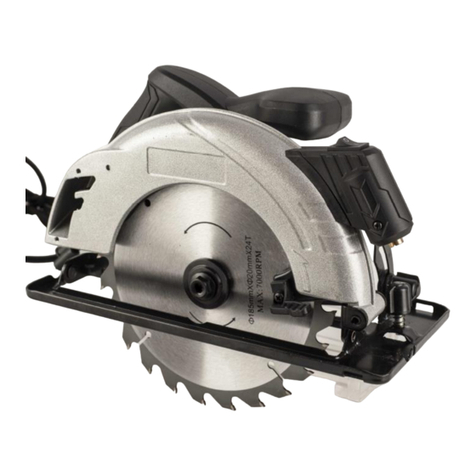
Feider Machines
Feider Machines FSC1485-B User manual
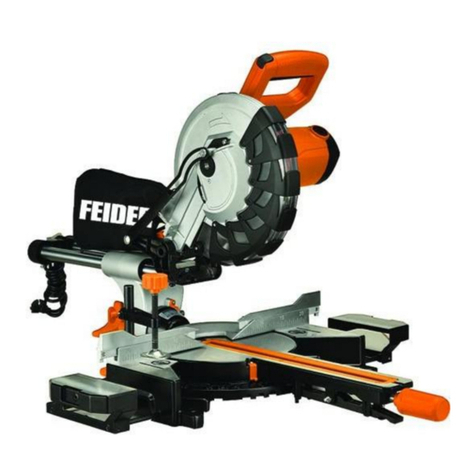
Feider Machines
Feider Machines FSOR20255 User manual
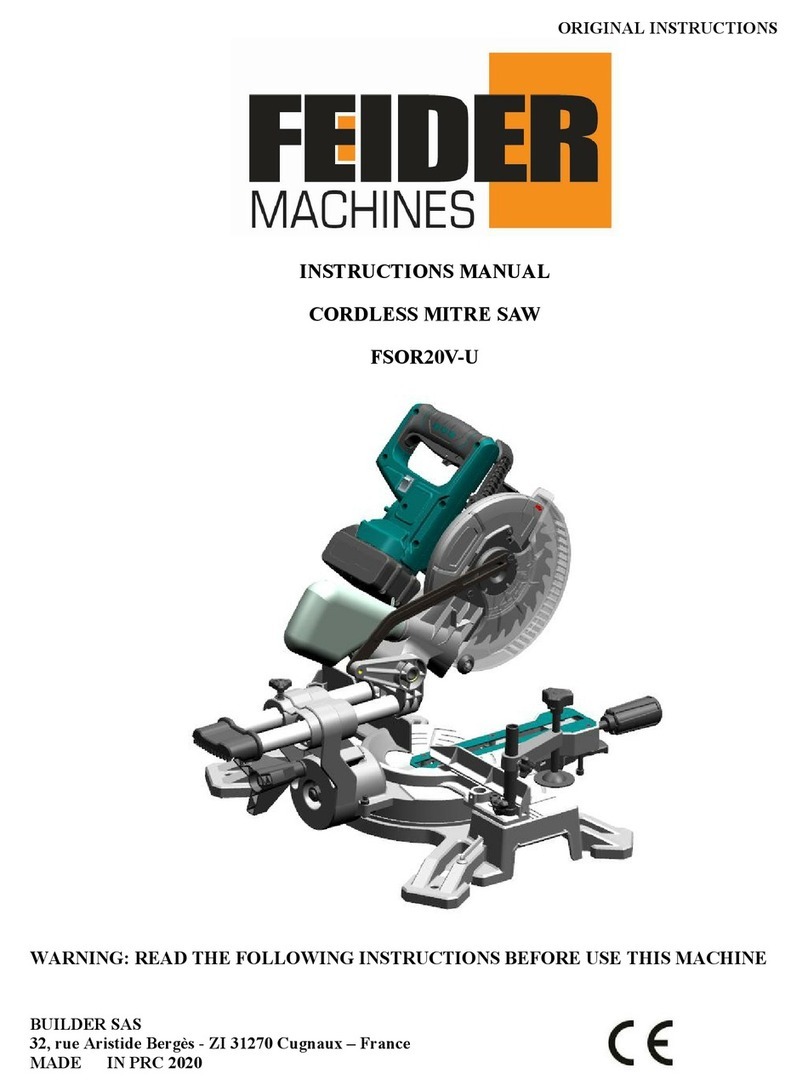
Feider Machines
Feider Machines FSOR20V-U User manual
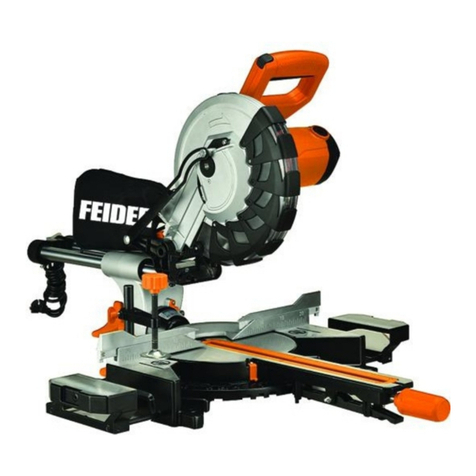
Feider Machines
Feider Machines FSO20254 User manual
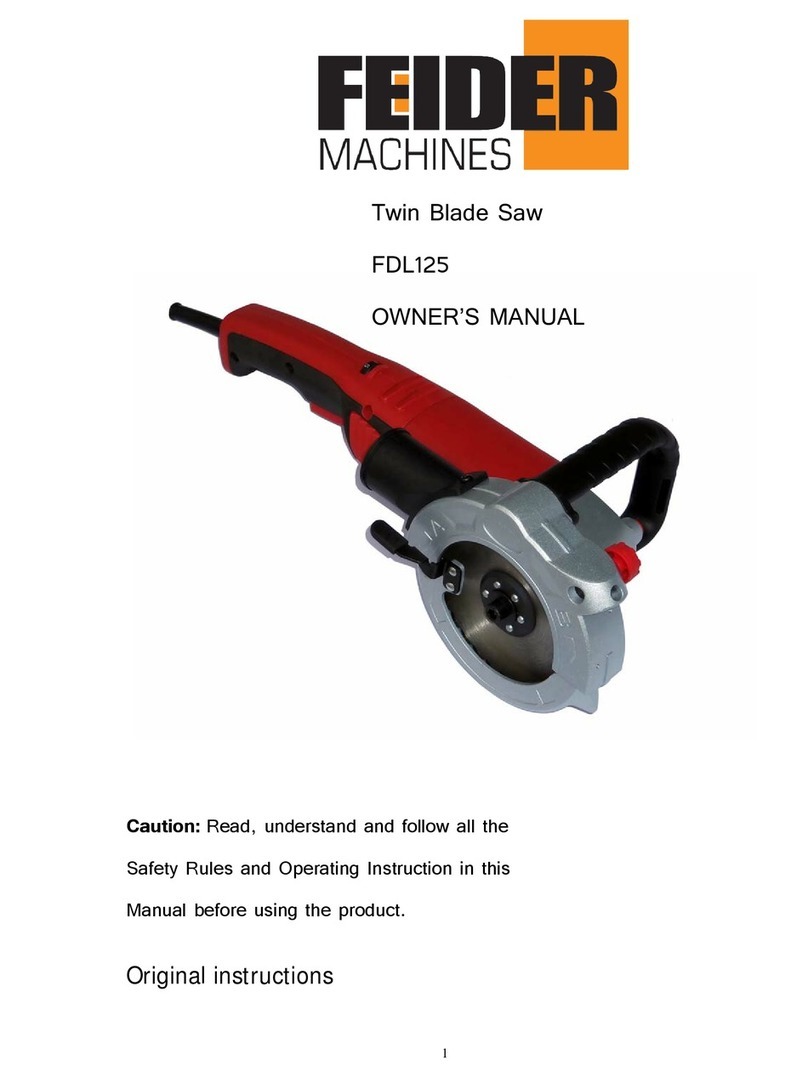
Feider Machines
Feider Machines FDL125 User manual

Feider Machines
Feider Machines FSSAB20V-B User manual
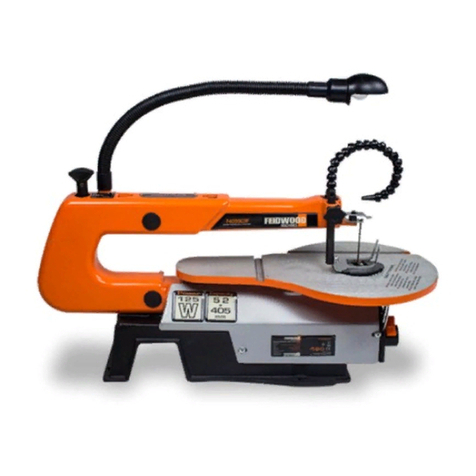
Feider Machines
Feider Machines F405SC3F User manual
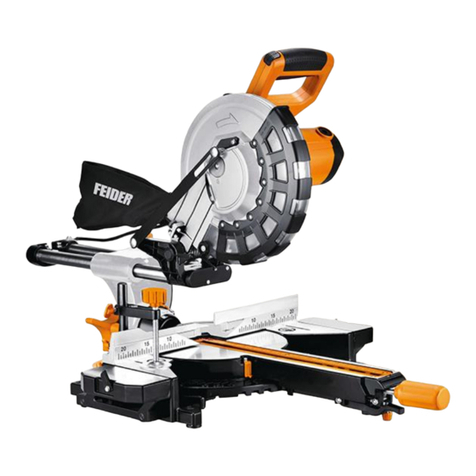
Feider Machines
Feider Machines FSOR17210 User manual
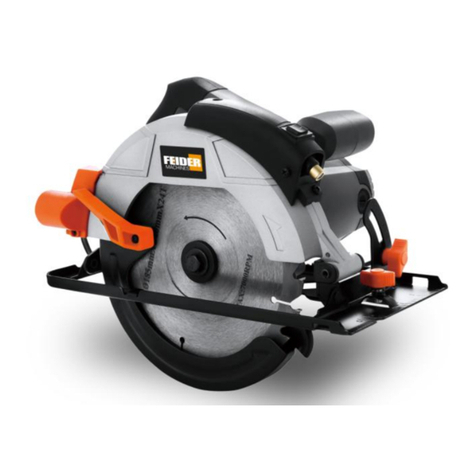
Feider Machines
Feider Machines FSC1485 User manual
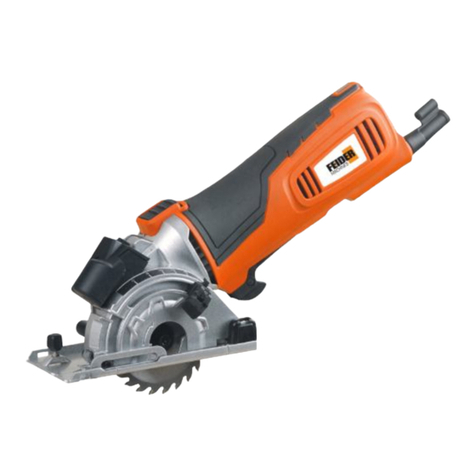
Feider Machines
Feider Machines FRX600 User manual

